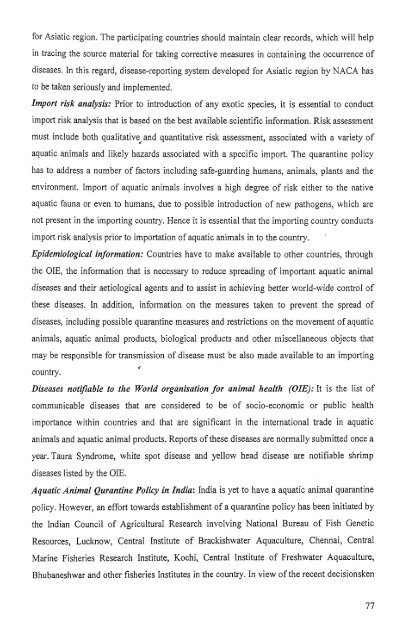, Diagnosis an-&& of Shrimp Diseases - Central Institute of ...
, Diagnosis an-&& of Shrimp Diseases - Central Institute of ...
, Diagnosis an-&& of Shrimp Diseases - Central Institute of ...
- No tags were found...
You also want an ePaper? Increase the reach of your titles
YUMPU automatically turns print PDFs into web optimized ePapers that Google loves.
for Asiatic region. The participating countries should maintain clear records, which will helpin tracing the source material for taking corrective measures in containing the occurrence <strong>of</strong>diseases. In this regard, disease-reporting system developed for Asiatic region by NACA hasto be taken seriously <strong>an</strong>d implemented.Import risk <strong>an</strong>alysis: Prior to introduction <strong>of</strong> <strong>an</strong>y exotic species, it is essential to conductimport risk <strong>an</strong>alysis that is based on the best available scientific information. Risk assessmentmust include both qualitative.<strong>an</strong>d qu<strong>an</strong>titative risk assessment, associated with a variety <strong>of</strong>aquatic <strong>an</strong>imals <strong>an</strong>d likely hazards associated with a specific import. The quar<strong>an</strong>tine policyhas to address a number <strong>of</strong> factors including safe-guarding hum<strong>an</strong>s, <strong>an</strong>imals, pl<strong>an</strong>ts <strong>an</strong>d theenvironment. Import <strong>of</strong> aquatic <strong>an</strong>imals involves a high degree <strong>of</strong> risk either to the nativeaquatic fauna or even to hum<strong>an</strong>s, due to possible introduction <strong>of</strong> new pathogens, which arenot present in the importing country. Hence it is essential that the importing country conductsimport risk <strong>an</strong>alysis prior to importation <strong>of</strong> aquatic <strong>an</strong>imals in to the country.Epidemiological information: Countries have to make available to other countries, throughthe OIE, the information that is necessary to reduce spreading <strong>of</strong> import<strong>an</strong>t aquatic <strong>an</strong>imaldiseases <strong>an</strong>d their aetiological agents <strong>an</strong>d to assist in achieving better world-wide control <strong>of</strong>these diseases. In addition, information on the measures taken to prevent the spread <strong>of</strong>diseases, including possible quar<strong>an</strong>tine measures <strong>an</strong>d restrictions on the movement <strong>of</strong> aquatic<strong>an</strong>imals, aquatic <strong>an</strong>imal products, biological products <strong>an</strong>d other miscell<strong>an</strong>eous objects thatmay be responsible for tr<strong>an</strong>smission <strong>of</strong> disease must be also made available to <strong>an</strong> importingcountry.<strong>Diseases</strong> notifiable to the World org<strong>an</strong>isation for <strong>an</strong>imal lzealtlz (OIE): It is the list <strong>of</strong>communicable diseases that are considered to be <strong>of</strong> socio-economic or public healthimport<strong>an</strong>ce within countries <strong>an</strong>d that are signific<strong>an</strong>t in the international trade in aquatic<strong>an</strong>imals <strong>an</strong>d aquatic <strong>an</strong>imal products. Reports <strong>of</strong> these diseases are normally submitted once ayear. Taura Syndrome, white spot disease <strong>an</strong>d yellow head disease are notifiable shrimpdiseases listed by the OIE.Aquatic Animal Qur<strong>an</strong>fine Policy in India: India is yet to have a aquatic <strong>an</strong>imal quar<strong>an</strong>tinepolicy. However, <strong>an</strong> effort towards establishment <strong>of</strong> a quar<strong>an</strong>tine policy has been initiated bythe Indi<strong>an</strong> Council <strong>of</strong> Agricultural Research involving National Bureau <strong>of</strong> Fish GeneticResources, Lucltnow, <strong>Central</strong> <strong>Institute</strong> <strong>of</strong> Brackishwater Aquaculture, Chennai, <strong>Central</strong>Marine Fisheries Research <strong>Institute</strong>, Kochi, <strong>Central</strong> <strong>Institute</strong> <strong>of</strong> Freshwater Aquaculture,Bhub<strong>an</strong>eshwar <strong>an</strong>d other fisheries <strong>Institute</strong>s in the country. In view <strong>of</strong> the recent decisionsken'
















